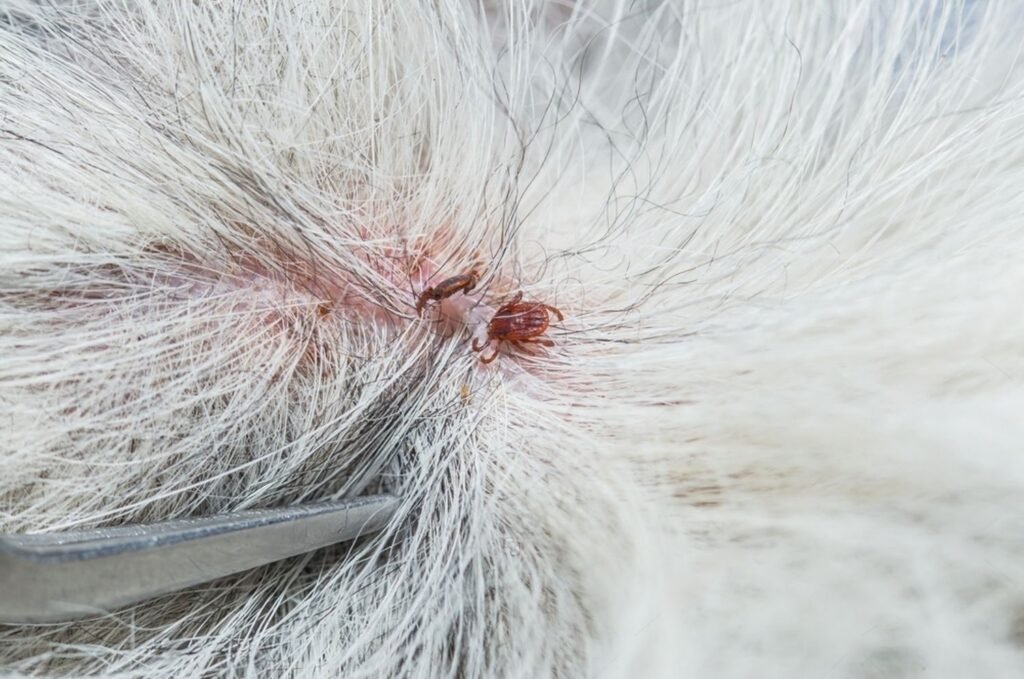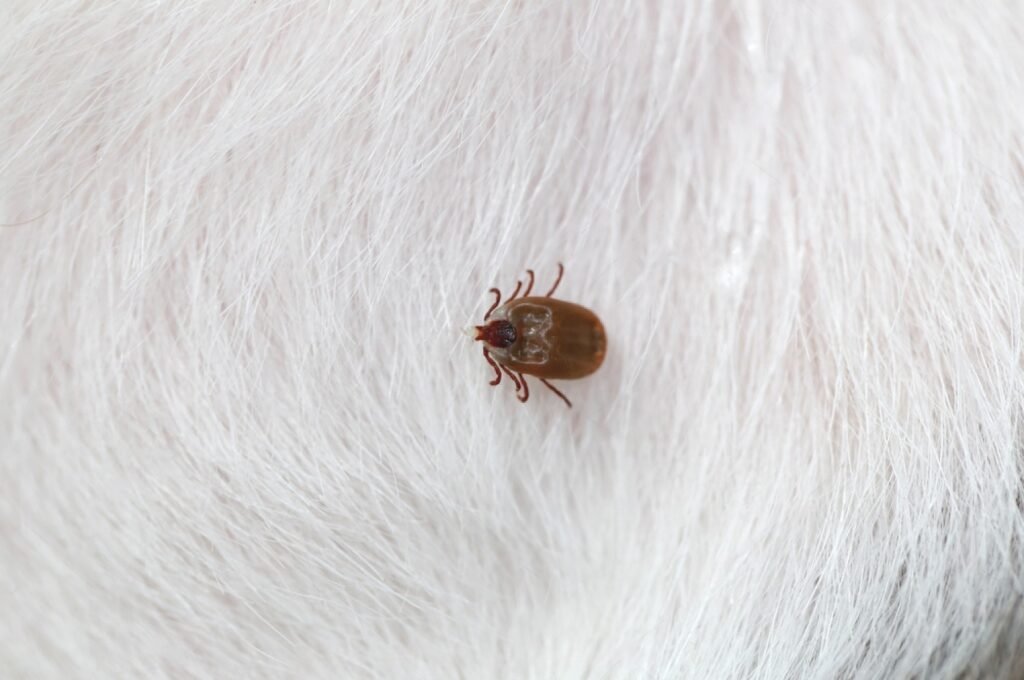
Ticks are more than just a nuisance for dogs—they can pose serious health risks. These tiny parasites latch onto your dog’s skin and feed on their blood, potentially transmitting harmful diseases like Lyme disease, ehrlichiosis, and anaplasmosis. In addition to spreading infections, ticks can cause skin irritation, redness, and discomfort. As a pet owner, keeping your dog tick-free is crucial, but finding the safest and most effective way to do so is often a concern.
Most pet parents are on the lookout for solutions that are both effective and safe for both their pets and the planet. The chemicals in typical tick prevention products may trigger allergic reactions, create toxic levels, and produce other unpleasant outcomes. This scenario has generated a stronger call for natural options that are competitively efficient yet chemical-free.
We’re aware at Petpawty, that pet parents are searching for secure, natural, and holistic methods to protect their dogs from issues with ticks. The focus of this guide is on discovering how to prevent ticks on dogs naturally, contrasting these natural solutions with chemical treatments for a more complete examination of your available choices concerning the health of your dog.

Many common tick prevention products rely on synthetic chemicals that, while effective at killing or repelling ticks, can pose health risks for your dog. Some of the most widely used ingredients in chemical tick treatments include:
While these chemicals can kill ticks quickly, the trade-off is the potential for side effects. Dogs with sensitive skin, allergies, or underlying health conditions may experience anything from minor irritation to more serious issues like vomiting, diarrhea, tremors, or long-term toxicity with repeated exposure. In addition, these treatments can pose risks to humans—especially children—who frequently interact with treated dogs. Pets may also develop resistance to these chemicals over time, making them less effective.
Given the potential risks, many pet owners are turning to natural tick prevention methods, which offer several distinct advantages:
Switching to natural tick prevention isn’t just about avoiding the potential downsides of chemicals; it’s about choosing a safer, more holistic path for your pet’s health. By opting for natural methods, you protect your dog from harsh substances while also promoting a cleaner, healthier environment—both for your pet and the world around them.

One of the most effective and popular natural tick prevention methods is the use of herbal repellents, particularly essential oils. These plant-based oils not only deter ticks but are also non-toxic, making them a safer alternative for both pets and humans. However, it’s important to use them correctly to ensure effectiveness and safety.
Lavender Oil is well-known for its calming properties, but it also has natural insect-repelling capabilities. Ticks are repelled by the strong fragrance, making it an excellent option for your dog. In addition to tick prevention, lavender is gentle on the skin and can soothe any existing irritation from bites or allergens.
Eucalyptus Oil is another powerful tick repellent due to its strong, menthol-like scent. Ticks find eucalyptus overwhelming, making it a great defense against them. However, eucalyptus oil should be diluted properly before applying it to your dog’s skin, as it can cause irritation if used in its pure form.
Cedarwood Oil is particularly effective against ticks because it disrupts their ability to sense prey, essentially making your dog invisible to them. This oil not only repels ticks but also kills them upon contact, offering double protection. Like other essential oils, it must be diluted to avoid skin irritation.
When using essential oils for tick prevention, it’s critical to dilute them with carrier oil, such as coconut or almond oil. A safe dilution ratio is typically 10-12 drops of essential oil per ounce of carrier oil. You can then apply the mixture directly to your dog’s coat, avoiding sensitive areas like the eyes, nose, and mouth. Alternatively, create a DIY tick spray by mixing the diluted essential oils with water in a spray bottle. This can be spritzed on your dog before outdoor activities or walks, focusing on areas like the neck, belly, and legs where ticks are more likely to latch on.
DIY Tick Sprays are simple to make, cost-effective, and can be tailored to your dog’s specific needs. For example, a lavender and cedarwood blend works well for general tick prevention, while adding a bit of apple cider vinegar can enhance the solution’s repellent properties. Sprays should be reapplied every few hours when outdoors, especially in areas with heavy tick populations.
The main advantage of using herbal tick repellents is that they offer an easy, affordable, and non-toxic solution for dog owners looking to avoid chemical treatments. These natural alternatives are safe when used properly, reducing the risk of allergic reactions, chemical sensitivities, and environmental harm. Plus, essential oils are readily available, making them a convenient option for most pet owners.
One of the most effective ways to keep ticks off your dog is by incorporating regular bathing into your grooming routine. Using tick-repellent shampoos with natural ingredients, like neem oil, can significantly reduce the chances of ticks latching onto your dog. Neem oil, derived from the neem tree, has powerful insect-repelling properties that are both safe and non-toxic for dogs. In addition to repelling ticks, neem oil soothes irritated skin and promotes a healthy coat, making it an ideal ingredient for natural tick prevention.
The frequency of bathing plays a crucial role in tick prevention. For active dogs or those living in tick-prone areas, weekly baths are recommended, especially during peak tick season (spring and summer). Bathing helps remove any ticks that may have crawled onto your dog’s coat and prevents them from embedding into the skin. In addition to bathing, regular brushing is equally important. A thorough brushing session after outdoor activities can remove loose ticks, debris, and dirt, keeping your dog’s coat clean and tick-free. Brushing should be done daily for dogs that spend a lot of time outside or in areas with high grass or wooded environments. Brushing every few days may be sufficient for less active dogs.
By integrating regular baths with natural shampoos and frequent brushing, you can create an effective, holistic grooming routine that significantly reduces the risk of ticks while keeping your dog’s coat healthy and shiny. This approach offers practical steps for daily and weekly prevention that are simple, effective, and safe.
Another essential part of your grooming routine should be daily tick checks, especially if your dog spends time outdoors in tick-infested areas. Even with the best prevention methods, ticks can still manage to latch onto your dog’s coat, and catching them early is key to preventing an infestation or disease transmission.
After walks or outdoor playtime, take a few minutes to thoroughly inspect your dog’s body for any ticks. Focus on areas where ticks are most likely to hide, such as the ears, and paws, between the toes, neck, and under the collar. These warm, moist areas provide an ideal environment for ticks to attach and feed. Running your hands gently over your dog’s skin will help you feel any small bumps or ticks that may be embedded. Using a fine-toothed comb or tick-removal tool can also help in catching ticks that are harder to see or feel.
Daily tick checks provide immediate steps to prevent infestation and allow you to address any ticks before they have a chance to bite and transmit diseases. Early detection is critical, as it reduces the chances of the tick spreading Lyme disease, ehrlichiosis, or other tick-borne illnesses. For long-haired or thick-coated breeds, consider trimming the fur around high-risk areas during tick season for easier checks.
By combining natural grooming practices like regular bathing, brushing, and daily tick checks, you can keep your dog safe from ticks without relying on harsh chemicals. This proactive, hands-on approach not only strengthens the bond between you and your pet but also ensures that you catch potential threats early on, minimizing health risks.
Ticks thrive in outdoor environments, particularly in tall grass, wooded areas, and places with dense foliage. To reduce the risk of ticks in your dog’s surroundings, proper yard maintenance is crucial. One of the simplest and most effective ways to control tick populations is by regularly mowing the grass. Keeping your lawn short minimizes the places where ticks can hide and wait for a host to pass by. In addition to mowing, it’s important to clear away leaf litter, tall weeds, and overgrown shrubs, as these areas provide ideal breeding grounds for ticks.
Another natural method to control ticks in your yard is to use diatomaceous earth, a powdery substance made from fossilized algae. Diatomaceous earth is completely natural and non-toxic to dogs but is lethal to ticks. When sprinkled in areas where your dog frequently plays—such as the yard, garden, or kennel area—it dehydrates and kills ticks upon contact. Be sure to choose food-grade diatomaceous earth for safety and reapply it after rain for continued effectiveness.
These holistic yard maintenance tips provide dog owners with practical ways to keep their dog’s living space safe from ticks. They offer a proactive approach without the need for harmful chemicals, allowing for a natural, dog-friendly environment.

In addition to yard maintenance, there are several natural tick deterrents that can further reduce tick populations in your yard. One highly effective method is using beneficial nematodes—microscopic worms that act as a biological control for ticks and other pests. Nematodes are harmless to dogs and humans but actively seek out and destroy tick larvae and nymphs in the soil. By releasing nematodes into the soil in tick-prone areas, you can naturally reduce tick populations without the need for synthetic pesticides.
Another natural deterrent is creating tick barriers around your yard using materials like cedar chips or gravel. Ticks are less likely to cross dry, inhospitable surfaces, so placing a three-foot-wide barrier of cedar chips or gravel between wooded areas and your lawn can help keep ticks out of your yard. Cedar, in particular, contains natural oils that repel ticks, making it an excellent choice for outdoor spaces where your dog frequently roams.
A common concern for many dog owners is whether natural tick prevention methods can be as effective as chemical solutions. While chemical treatments like spot-on products or oral medications can offer strong and long-lasting protection, they also come with potential risks such as allergic reactions, skin irritations, or even long-term health effects from chemical exposure. This has led many pet owners to seek natural alternatives, but reassurance is needed about their effectiveness.
Natural tick prevention methods, such as using essential oils, herbal repellents, and yard maintenance practices, can be highly effective when used consistently and correctly. While they may not offer the same level of immediate protection as chemicals, their effectiveness can be enhanced when multiple methods are combined. For example, regularly applying diluted essential oils, ensuring daily tick checks, and maintaining your dog’s environment with yard control measures can work together to create a comprehensive defense against ticks.
For users looking for maximum protection, combining methods like herbal sprays, regular grooming, and tick-repellent yard maintenance ensures a more robust and holistic approach to tick prevention. While natural methods might require more hands-on effort, they provide a safer, non-toxic solution that avoids the potential health risks associated with chemicals. Pet owners can achieve stronger protection by being diligent and layering different preventive techniques.
Despite your best efforts, it’s still possible for a tick to attach itself to your dog, especially if you live in a tick-prone area. If this happens, knowing how to safely and effectively remove the tick is crucial. Using natural tick removal tools, such as fine-tipped tweezers or a tick removal tool, you can remove the tick without leaving any parts of it behind. Always grab the tick as close to the skin as possible, applying steady pressure to pull it out without twisting. Be gentle to avoid squeezing the tick, as this could push harmful bacteria into your dog’s bloodstream.
Once the tick is removed, it’s important to clean the area thoroughly to prevent infection. Applying diluted essential oils, such as tea tree oil or lavender oil, can help soothe the skin and reduce the risk of any secondary infections. These oils have antimicrobial properties that aid in healing, while also naturally repelling future ticks. Keep an eye on the area for the next few days to ensure no signs of infection or irritation arise.
In case prevention efforts fail, it’s essential to be prepared with the right tools and knowledge. These natural removal techniques not only offer immediate guidance but also give dog owners peace of mind, knowing they can address the situation safely and effectively without resorting to harsh chemicals.
Natural tick prevention provides a safe, eco-friendly alternative to chemical treatments, protecting your dog without harmful side effects. Using essential oils, regular grooming, and effective yard maintenance can create a strong defense against ticks while promoting your dog’s overall health.
For best results, take an integrative approach—combine regular grooming, a balanced diet, and natural tick deterrents in your yard. Consistency is one of the main reasons why these methods can help keep your dog tick-free and healthy throughout the season. Start applying these strategies for safer, holistic care today.